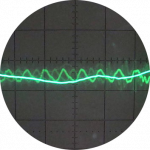Controversial opinions - pure weather compensation, buffer tank, heat loss, oversized heat pumps
Posted by: @transparentI don't think that will work because compressors can't operate at very low speed.
Hummm....this depends on the type of compressor.
For a typical positive displacement compressor (think medical syringe moving backwards and forwards), they can operate a very low speeds.
Turbo compressors, think jet engines, can't operate at low speeds. (look up compressor stall / surge / stonewall if you're interested).
Trouble is ASHP aren't using plunger compressors, they're either rotary or scroll type. These compressors have internal leakage which means some gas gets "left behind" inside the compressor. At low speeds there is more internal leakage than forward flow, so they stop pumping i.e. they don't work well at low speed. These designs will also use the lubrication oil as a seal fluid to prevent internal leakage, which then allows the machine to operate a slow speeds - but with higher internal friction, therefore loosing out on overall efficiency.
Again, this illustrates nicely just how difficult it is to select a device purely based on "efficiency".
Any device should be selected so that it works well over the required operating range - this does not necessarily mean "the most efficient".
We've not even spoken about the initial cost of a larger heat pump vs a small heat pump. In the example above, assuming a 10year life, would the customer spend less money with the 8kW machine than they would with the 11kW machine?
Regards
Bob
Posted by: @heatgeekA UFH system with insulated floating screed floor, tog 1 carpet and 20cm pipe spacing has a fixed System Performance Factor (SPF) of 3 W/m2K.
Note for those who wish to follow this discussion but are wary of the maths...
There is a BEAMA Guide to underfloor heating which compares the SPF of different flooring materials.
it has illustrations and reference tables.
Beware that the letters SPF are also used to describe the Seasonal Performance Factor for a heat-pump.
The difference should be apparent if you check the context.
Save energy... recycle electrons!
Posted by: @bobtskutter
We've not even spoken about the initial cost of a larger heat pump vs a small heat pump. In the example above, assuming a 10year life, would the customer spend less money with the 8kW machine than they would with the 11kW machine?
This is a very valid point, one that could be modelled out quite easily
Posted by: @heatgeek@jamespa I have been quietly following all of this in amazement at some of the statements, especially about over-sized HP’s being more efficient. The comments by @jamespa are absolutely correct. Let me provide a parallel view. Imagine you are trying to heat a large metal cooking pot on a fire outside on a winter’s day and you want to keep a constant water temperature. With the right size fire the metal pot will heat up to the temperature at which balance is achieved between the heat input and the heat output from the pot which will be sustained for a constant outside temperature. If we only have a big on/off flame, we can overheat the pot by, say, 1C more and then let it cool -1C down before applying heat again. The bigger the flame the more on/offs. The average required temperature will be sustained (with hysteresis) but the actual heat energy applied to the pot will be the same regardless.
The same applies to a house. The flame is the floor in a UFH system and the pot is the room above with its internal air and its walls to the outside temperature. A UFH system with insulated floating screed floor, tog 1 carpet and 20cm pipe spacing has a fixed System Performance Factor (SPF) of 3 W/m2K. A certified Passivhaus must meet a space heating limit of 10W/m2 at peak demand. A 500 sqm Passivhaus will therefore lose 5kW at this limit. To supply constant 10W/m2 @ SPF 3 requires a delta-T of 3.33C (3 x 3.33 = 10) or MWT 23.3C for 20C room temperature (25.8C flow). If this 24 h heat load is concentrated over 12 hours and the room then left to cool for 12 hours, double the heat output is required for 12 hours, therefore the delta-T must be doubled (6.66C) with flow of 29.2C. The 24h heat loss @ 20C average room temperature is the same however you heat it. Therefore, assuming fixed outdoor temperature, you can heat constantly @ 26C flow or for 12 hours @ 29C flow with slightly worse COP. The size of the heat pump is irrelevant as long as it can supply peak 5kW load and cater for lower loads efficiently. However, a 13kW heat pump would need to demodulate down to 5kW before cycling. Below this peak demand, it will struggle. The situation with an average house losing 60W/m2 will be 6 times worse with wide COP difference. Furthermore, to say that heating constantly at 23C room temperature costs 3 times more than 12 hour concentrated heating at 20C, and therefore constant heating at 20C should not be used is frankly ridiculous. And WC is useless......🤨
I think it's clear that the general conclusions that apply to the vast majority of UK housing stock, may not apply to the tiny minority which are low loss/eco houses with very low heating requirements. Furthermore there are good theoretical reasons why this is the case. Of course the latter probably, at least for now, represent a disproportionate subset of heat pump installations (although not necessarily the majority).
In any statement about 'best approach' it's therefore vital to distinguish which case the statement applies to and equally vital not to assume that it applies to the other case.
Any statement I make is intended to apply to the vast majority of UK housing stock not the low loss/eco house special case, unless I say otherwise. I will henceforth repeat this from time to time!
4kW peak of solar PV since 2011; EV and a 1930s house which has been partially renovated to improve its efficiency. 7kW Vaillant heat pump.
@uk_pete_2000 Sorry, I forgot to say that in my second case of 12 hour heating period, a double size HP would be required i.e. 10kW to deliver double the load (120kWh in 12 hours). This is the only way you could operate with such a large HP (bigger flame). As pointed out before, if heating is continuous then it would cycle endlessly at <5kW output as it is too big and cost will be high. The flow temperature is a function of the efficiency of your heat emitters. For example, a 15cm pipe spacing would increase SPF to 3.3 and MWT would then be 26C in my example. When talking flow, one must distinguish between flow leaving the HP and the average flow temp in the floor with 5C delta-T. My figures are notional. The figure for Passivhaus is a minimum limit and actual heat loss will depend on your own level of insulation. Having said that, I am still trying to get my head around what you are saying is happening (when I get the time). Will get back.
Private individual. No affiliation with commercial "Heat Geeks" of same coincidental name.
Posted by: @uk_pete_2000We could change the HP to a 4-6kw unit and run at say 20-21 flow temp, but i don't think we would save anything running it 24/7. Having a larger HP means we get less de-icing, slower fan and compressor speeds. Having a buffer means the HP does not cycle. When we tested 24/7 it started to introduce cycling, as the return temp increased over time to match the flow temp. The only way we could stop this was to go back to on / off operation
Just a thought, do you have underfloor heating?
The comment "started cycling as the return temp increased" makes me think you're seeing a benefit of having a low return water temperature.
regards
bob
Posted by: @bobtskutterPosted by: @uk_pete_2000We could change the HP to a 4-6kw unit and run at say 20-21 flow temp, but i don't think we would save anything running it 24/7. Having a larger HP means we get less de-icing, slower fan and compressor speeds. Having a buffer means the HP does not cycle. When we tested 24/7 it started to introduce cycling, as the return temp increased over time to match the flow temp. The only way we could stop this was to go back to on / off operation
Just a thought, do you have underfloor heating?
The comment "started cycling as the return temp increased" makes me think you're seeing a benefit of having a low return water temperature.
regards
bob
Yes we have about 300m² on two manifolds, 16 loops. Another manifold is for upstairs rads
Here's a quick spreadsheet I put together that shows how compressor discharge temperature varies according to pressure ratio.
The data is based on Propane, R290 (because that's what was on the Air Liquide web site)
You must have the return water temperature to the ASHP less than the condensation temperature of Propane at the compressor discharge pressure.
If your return temperature is 27C, you can have a pressure ratio of 10
If your return temperature is 47C, you need a pressure ratio of 16
i.e. increasing the return water temperature from 27C to 47C will require 60% more compressor power (because compressor power is proportional to pressure ratio).
Regards
Bob
@uk_pete_2000 I have perused your data again. As far as I can see there is no way that you can efficiently use such a large HP to directly heat your emitters. You are focussed on lowering temperature as a metric for direct heating. Temperature has no effect on heat delivery, it only slows down the delivery of heat from the emitter to the room. The heat delivered by 25/20C flow is exactly the same as 40/35C. Let’s look at flow instead. You need 37 l/min flow for 13kW (5C delta-T). The HP may be able to modulate down to 6kW or 17 l/min flow. If you need 3kW heat on a milder day, emitters will require 8.5 l/min flow. The HP can only deliver 17 l/min minimum so half the flow will go to emitters and half routed back to HP through the buffer tank. This cannot be good. Another problem is that reducing flow down to 23C screws up your radiators. They are non-linear unlike the UFH and cause distortion with the UFH. This is the same problem that I have. Therefore you should choose the minimum heat temperature for the radiators to operate efficiently at 12-15C outside temperature.
Therefore the only way I can see that you can use this HP efficiently is to change the buffer tank for a 300l thermal store and use a 5C hysteresis in the store. Add a mild form of WC e.g. 30/25C @ 15C and 35/30C at low end. If 30/25C works across the board with radiators then keep this. The HP will be decoupled from the emitters completely and will heat the store directly. With 13kW a 5C uplift from 25C to 30C will take around 1.5 hours (~20kWh charge) off the top of my head and HP operation will be continuous and efficient. Then the emitters will draw water at leisure over the next 7-8 hours before the HP kicks in again. Twice a day HP heating will probably be enough therefore you can make use of timed off-peak periods. As emitters are now independent of flow constraints, you can make liberal use of thermostats for individual temperature control and save more. A simple thermal store is a much cheaper option than a new smaller HP. Use 2 sensors in a latch to ensure HP heats the store down to the bottom. Emitters draw from the top. A vice now becomes a virtue.
Hope this gives some food for thought.
Private individual. No affiliation with commercial "Heat Geeks" of same coincidental name.
@uk_pete_2000 I think we have some misunderstandings here. You previously indicated that you have a passive house (<10W/m2 or ~5kW peak loss) but it now seems that you actually have a previous standard new build. Your heat loss could therefore be nearer 20W/m2 or 10kW peak. Allowing a margin for DHW, etc implies that the sizing of your HP is in the right ballpark. This negates all my previous comments as I took it that your peak heat loss is less than the minimum output of your HP. You are focussed on your kWh electricity usage when you should be assessing your kW heat loss. When I mentioned 20kWh for the tank, this was for heat input from the HP. At a COP of 5, this equates to 4kWh electricity input. You cannot plan or change anything unless you have an understanding of your house heat loss in kWs, not kWhs of electricity. Regarding flows, you have 4 manifolds with a flow meter on each loop/radiator, don’t you? What are the l/min readings on these? Does each manifold have a pump/mixer or is there only one post-buffer pump for all? What is the model and speed setting on these pumps? Do you have u-values and dimensions for all walls, floor, roof and windows? What is the pipe spacing on your UFH, screed type and floor covering? You are also operating the heating intermittently which is distorting the value of real heat loss if you only look at the electricity consumed.
It is impossible to give you any suggestions without accurate information.
Private individual. No affiliation with commercial "Heat Geeks" of same coincidental name.
- 26 Forums
- 2,356 Topics
- 53.4 K Posts
- 181 Online
- 6,017 Members
Join Us!
Worth Watching
Latest Posts
-
RE: Octopus Cosy Heat Pump Owners & Discussion Thread
@andrewj Seeing they deleted both threads with the pict...
By HarrisonC , 9 hours ago
-
RE: Who's your electricity provider and what's your tariff?
@mars I think your commentary is very fair and balanc...
By JamesPa , 9 hours ago
-

RE: External pipework insulation
That's great advice @transparent... thank you. @david...
By Mars , 10 hours ago
-
RE: Advice on internal circulation pump noise
Thanks @mikefl - I'll maybe have a look at the lock-shi...
By jtg , 11 hours ago
-

RE: Heat Pump Heats the House… But It’s Not Cosy. Emitter Changes or System Tweak?
@toodles interesting suggestion, thanks. I will try to...
By GrahamF , 12 hours ago
-
RE: Mitsubishi Ecodan Auto Adaption trial to stop cycling.
The interval you talk of, i think, will be 60min for an...
By F1p , 15 hours ago
-

RE: Electricity price predictions
Does anyone have a current graphic, visual or breakdown...
By Mars , 19 hours ago
-
Agree with @majordennisbloodnok on the setbacks. We hav...
By ChandyKris , 1 day ago
-
RE: New Fogstar 15.5kWh upright solution
It is a matter of luck. 2ith Fogstar "instructions", to...
By Batpred , 1 day ago
-

RE: Speedcomfort radiator fans
@deltona the way the links were added broke the page. A...
By Mars , 1 day ago
-

RE: Setback savings - fact or fiction?
I agree! Even more so if we get an answer! But the chal...
By cathodeRay , 2 days ago
-

RE: Refrigerant R32, is it now banned in the EU from 1st Jan 2027 for monobloc ASHPs?
This has been delayed from what I believe to be this ye...
By dgclimatecontrol , 2 days ago
-
RE: Are We Sleepwalking Into Another Race to the Bottom?
this is why I provided current flow temperatures in the...
By ksim , 2 days ago
-

RE: Why Millions of UK Homes Struggle With Heat Pumps
There's many homes that would be quite a disruption for...
By dgclimatecontrol , 2 days ago
-
RE: Ecodan unable to hit legionella target temp - what's the consensus?
@rhh2348 ...maybe this option is what you want? Alter...
By benson , 2 days ago
-

RE: Free Ecoheat Heat Pump Install
@old_scientist This does make the unit smaller as the b...
By dgclimatecontrol , 2 days ago
-
RE: Ecodan - Legionella Operation Time and Target Temperature
@old_scientist hiya mate, did you ever get to the botto...
By 9jwr9 , 2 days ago
-
RE: Configuring third party dongle for Ecodan local control
@majordennisbloodnok I think the HPDHD diagnosis may be...
By Sheriff Fatman , 3 days ago




